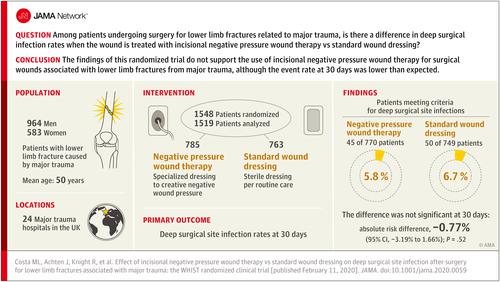Our official English website, www.x-mol.net, welcomes your
feedback! (Note: you will need to create a separate account there.)
Effect of Incisional Negative Pressure Wound Therapy vs Standard Wound Dressing on Deep Surgical Site Infection After Surgery for Lower Limb Fractures Associated With Major Trauma
JAMA ( IF 63.1 ) Pub Date : 2020-02-11 , DOI: 10.1001/jama.2020.0059 Matthew L Costa 1 , Juul Achten 1 , Ruth Knight 2 , Julie Bruce 3 , Susan J Dutton 2 , Jason Madan 3 , Melina Dritsaki 2 , Nick Parsons 4 , Miguel Fernandez 1 , Richard Grant 5 , Jagdeep Nanchahal 1 ,
JAMA ( IF 63.1 ) Pub Date : 2020-02-11 , DOI: 10.1001/jama.2020.0059 Matthew L Costa 1 , Juul Achten 1 , Ruth Knight 2 , Julie Bruce 3 , Susan J Dutton 2 , Jason Madan 3 , Melina Dritsaki 2 , Nick Parsons 4 , Miguel Fernandez 1 , Richard Grant 5 , Jagdeep Nanchahal 1 ,
Affiliation

|
Importance
Following surgery to treat major trauma-related fractures, deep wound infection rates are high. It is not known if negative pressure wound therapy can reduce infection rates in this setting. Objective
To assess outcomes in patients who have incisions resulting from surgery for lower limb fractures related to major trauma and were treated with either incisional negative pressure wound therapy or standard wound dressing. Design, Setting, and Participants
A randomized clinical trial conducted at 24 trauma hospitals representing the UK Major Trauma Network that included 1548 patients aged 16 years or older who underwent surgery for a lower limb fracture caused by major trauma from July 7, 2016, through April 17, 2018, with follow-up to December 11, 2018. Interventions
Incisional negative pressure wound therapy (n = 785), which involved a specialized dressing used to create negative pressure over the wound, vs standard wound dressing not involving negative pressure (n = 763). Main Outcomes and Measures
The primary outcome measure was deep surgical site infection at 30 days diagnosed according to the criteria from the US Centers for Disease Control and Prevention. A preplanned secondary analysis of the primary outcome was performed at 90 days. The secondary outcomes were patient-reported disability (Disability Rating Index), health-related quality of life (EuroQol 5-level EQ-5D), surgical scar assessment (Patient and Observer Scar Assessment Scale), and chronic pain (Douleur Neuropathique Questionnaire) at 3 and 6 months, as well as other local wound healing complications at 30 days. Results
Among 1548 participants who were randomized (mean [SD] age, 49.8 [20.3] years; 561 [36%] were aged ≤40 years; 583 [38%] women; and 881 [57%] had multiple injuries), 1519 (98%) had data available for the primary outcome. At 30 days, deep surgical site infection occurred in 5.84% (45 of 770 patients) of the incisional negative pressure wound therapy group and in 6.68% (50 of 749 patients) of the standard wound dressing group (odds ratio, 0.87 [95% CI, 0.57 to 1.33]; absolute risk difference, -0.77% [95% CI, -3.19% to 1.66%]; P = .52). There was no significant difference in the deep surgical site infection rate at 90 days (11.4% [72 of 629 patients] in the incisional negative pressure wound therapy group vs 13.2% [78 of 590 patients] in the standard wound dressing group; odds ratio, 0.84 [95% CI, 0.59 to 1.19]; absolute risk difference, -1.76% [95% CI, -5.41% to 1.90%]; P = .32). For the 5 prespecified secondary outcomes reported, there were no significant differences at any time point. Conclusions and Relevance
Among patients who underwent surgery for major trauma-related lower limb fractures, use of incisional negative pressure wound therapy, compared with standard wound dressing, resulted in no significant difference in the rate of deep surgical site infection. The findings do not support the use of incisional negative pressure wound therapy in this setting, although the event rate at 30 days was lower than expected. Trial Registration
isrctn.org Identifier: ISRCTN12702354.
中文翻译:

切口负压伤口治疗与标准伤口敷料对严重创伤相关下肢骨折术后深部手术部位感染的影响
重要性 在手术治疗与外伤相关的重大骨折后,深部伤口感染率很高。目前尚不清楚负压伤口疗法是否可以降低这种情况下的感染率。目的 评估因严重创伤相关的下肢骨折手术导致切口并接受切口负压伤口治疗或标准伤口敷料治疗的患者的结果。设计、设置和参与者 在代表英国重大创伤网络的 24 家创伤医院进行的一项随机临床试验,包括 1548 名 16 岁或以上的患者,他们在 2016 年 7 月 7 日至 4 月期间接受了因重大创伤引起的下肢骨折手术2018 年 17 月 17 日,随访至 2018 年 12 月 11 日。 介入切口负压伤口治疗(n = 785),其中涉及用于在伤口上产生负压的专用敷料,而标准伤口敷料不涉及负压(n = 763)。主要结果和测量 主要结果测量是根据美国疾病控制和预防中心的标准在 30 天内诊断出的深部手术部位感染。在 90 天时对主要结果进行了预先计划的次要分析。次要结果是患者报告的残疾(残疾评级指数)、健康相关的生活质量(EuroQol 5-level EQ-5D)、手术疤痕评估(患者和观察者疤痕评估量表)和慢性疼痛(Douleur Neuropathique Questionnaire)在 3 和 6 个月时,以及在 30 天时出现其他局部伤口愈合并发症。结果 在随机分配的 1548 名参与者中(平均 [SD] 年龄,49.8 [20. 3年; 561 [36%] 年龄≤40 岁;583 [38%] 名女性;881 人 [57%] 有多处受伤),1519 人(98%)有主要结果的可用数据。在 30 天时,切口负压伤口治疗组的 5.84%(770 名患者中的 45 名)和标准伤口敷料组的 6.68%(749 名患者中的 50 名)发生深部手术部位感染(优势比,0.87 [95%) CI,0.57 至 1.33];绝对风险差异,-0.77% [95% CI,-3.19% 至 1.66%];P = .52)。90 天时深部手术部位感染率无显着差异(切口负压伤口治疗组为 11.4% [629 名患者中的 72 名],而标准伤口敷料组为 13.2% [590 名患者中的 78 名];优势比) ,0.84 [95% CI,0.59 至 1.19];绝对风险差异,-1.76% [95% CI,-5.41% 至 1.90%];P = .32)。对于报告的 5 个预先指定的次要结果,在任何时间点都没有显着差异。结论和相关性在接受严重创伤相关下肢骨折手术的患者中,与标准伤口敷料相比,使用切口负压伤口治疗导致手术部位深部感染率无显着差异。研究结果不支持在这种情况下使用切口负压伤口治疗,尽管 30 天的事件发生率低于预期。试用注册 isrctn.org 标识符:ISRCTN12702354。与标准伤口敷料相比,导致手术部位深部感染率无显着差异。研究结果不支持在这种情况下使用切口负压伤口治疗,尽管 30 天的事件发生率低于预期。试用注册 isrctn.org 标识符:ISRCTN12702354。与标准伤口敷料相比,导致手术部位深部感染率无显着差异。研究结果不支持在这种情况下使用切口负压伤口治疗,尽管 30 天的事件发生率低于预期。试用注册 isrctn.org 标识符:ISRCTN12702354。
更新日期:2020-02-11
中文翻译:

切口负压伤口治疗与标准伤口敷料对严重创伤相关下肢骨折术后深部手术部位感染的影响
重要性 在手术治疗与外伤相关的重大骨折后,深部伤口感染率很高。目前尚不清楚负压伤口疗法是否可以降低这种情况下的感染率。目的 评估因严重创伤相关的下肢骨折手术导致切口并接受切口负压伤口治疗或标准伤口敷料治疗的患者的结果。设计、设置和参与者 在代表英国重大创伤网络的 24 家创伤医院进行的一项随机临床试验,包括 1548 名 16 岁或以上的患者,他们在 2016 年 7 月 7 日至 4 月期间接受了因重大创伤引起的下肢骨折手术2018 年 17 月 17 日,随访至 2018 年 12 月 11 日。 介入切口负压伤口治疗(n = 785),其中涉及用于在伤口上产生负压的专用敷料,而标准伤口敷料不涉及负压(n = 763)。主要结果和测量 主要结果测量是根据美国疾病控制和预防中心的标准在 30 天内诊断出的深部手术部位感染。在 90 天时对主要结果进行了预先计划的次要分析。次要结果是患者报告的残疾(残疾评级指数)、健康相关的生活质量(EuroQol 5-level EQ-5D)、手术疤痕评估(患者和观察者疤痕评估量表)和慢性疼痛(Douleur Neuropathique Questionnaire)在 3 和 6 个月时,以及在 30 天时出现其他局部伤口愈合并发症。结果 在随机分配的 1548 名参与者中(平均 [SD] 年龄,49.8 [20. 3年; 561 [36%] 年龄≤40 岁;583 [38%] 名女性;881 人 [57%] 有多处受伤),1519 人(98%)有主要结果的可用数据。在 30 天时,切口负压伤口治疗组的 5.84%(770 名患者中的 45 名)和标准伤口敷料组的 6.68%(749 名患者中的 50 名)发生深部手术部位感染(优势比,0.87 [95%) CI,0.57 至 1.33];绝对风险差异,-0.77% [95% CI,-3.19% 至 1.66%];P = .52)。90 天时深部手术部位感染率无显着差异(切口负压伤口治疗组为 11.4% [629 名患者中的 72 名],而标准伤口敷料组为 13.2% [590 名患者中的 78 名];优势比) ,0.84 [95% CI,0.59 至 1.19];绝对风险差异,-1.76% [95% CI,-5.41% 至 1.90%];P = .32)。对于报告的 5 个预先指定的次要结果,在任何时间点都没有显着差异。结论和相关性在接受严重创伤相关下肢骨折手术的患者中,与标准伤口敷料相比,使用切口负压伤口治疗导致手术部位深部感染率无显着差异。研究结果不支持在这种情况下使用切口负压伤口治疗,尽管 30 天的事件发生率低于预期。试用注册 isrctn.org 标识符:ISRCTN12702354。与标准伤口敷料相比,导致手术部位深部感染率无显着差异。研究结果不支持在这种情况下使用切口负压伤口治疗,尽管 30 天的事件发生率低于预期。试用注册 isrctn.org 标识符:ISRCTN12702354。与标准伤口敷料相比,导致手术部位深部感染率无显着差异。研究结果不支持在这种情况下使用切口负压伤口治疗,尽管 30 天的事件发生率低于预期。试用注册 isrctn.org 标识符:ISRCTN12702354。











































 京公网安备 11010802027423号
京公网安备 11010802027423号